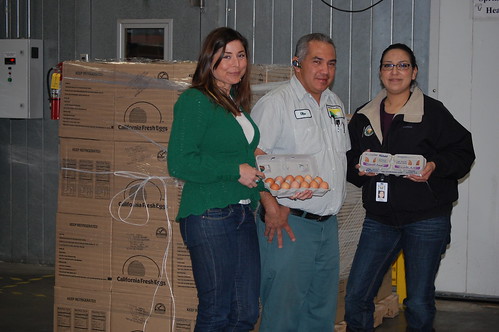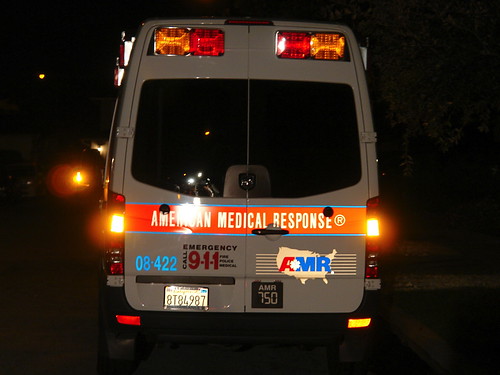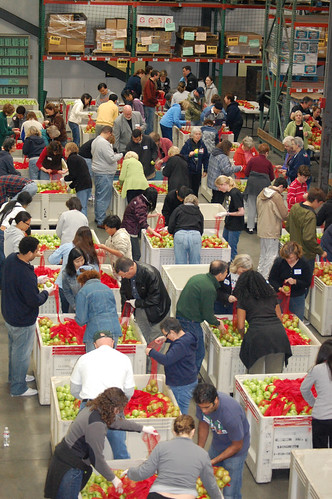Across the board, the waistline of America is growing. You can see it in every demographic, including those struggling with poverty.
Last month, the results of a national hunger study were released by Feeding America, and we highlighted
local statistics on our blog. Around the same time, First Lady Michelle Obama and USDA Secretary Tom Vilsack announced
their campaigns against the childhood obesity epidemic, which is tied to food insecurity and poverty. Comparing the overlapping demographics of those who are hungry and those at risk for obesity, people across the nation are starting to ask,
"How is this possible? How can someone be hungry and obese at the same time?"
We think this is an excellent question, and hopefully the following will shed some light on the matter.
Many wonder how people in low-income families—often living below the poverty line—seem to be suffering from an excessive intake of calories while struggling to put food on the table. As
Lynn Crocker, the Food Bank's director of marketing and communications, is often heard saying, "In America, we don't have famine. We have food insecurity and food insecurity means that a large portion of our population does not have consistent access to a steady supply of healthy, nutritious food."
To sum it up, calories are cheap while nutrient-dense food is not.
FRAC (the Food Research and Action Council) has, for years now, been leading the way in dispelling the debilitating stigma that surrounds this issue. Their
research proves an invaluable resource when trying to understand "food insecurity."
One of the most disturbing points they make is how poverty and obesity is cyclical in nature. Discrimination in the fields of education and employment against those who are obese leads to households that are more likely to be poor and food insecure. This highlights the importance of Vilsack and Michelle Obama's focus in this arena.
Studies have shown that children participating in Child Nutrition programs are less likely to be or become obese than those in the same income populations who do not participate because of their access to a regular source of food at school.
On the topic of nutrition in schools, the
PTA cited studies that "poor nutrition, even in non-overweight children, can affect brain development and performance in school. Children without proper nutrition may have a shorter attention span, more irritability, and more suspensions." Combined with this, obese children tend to have higher absenteeism rates, the cost of which is higher than just their education. Some public school districts lose millions of dollars in school funding each year to absenteeism. Participating in the School Nutrition Programs has been "shown to improve standardized test scores, improve attendance, decrease tardiness, and improve participation in class." The School Breakfast Program provides students with at least one fourth of the recommended levels for key nutrients, and the School Lunch Program provides one third.
At Second Harvest, we recognized that low-income families need additional food on weekends and so developed the
Kids NOW program. Working in partnership with Boys and Girls Clubs in low-income neighborhoods, this program distributes nutritious, easy-to-prepare foods on Friday afternoons. The food helps bridge the gap between lunch on Friday and breakfast Monday morning while children are out of school.
Making sure children in the at-risk populations are receiving consistent, nutritious food will help end the epidemic of obesity caused by food insecurity.
Food insecurity often leads to binge eating in both adults and children, and when finances don't allow for healthy food choices, the menu will be low-cost, high-calorie, and nutrient poor. This diagram of a supermarket helps illustrate the point:
COST PER CALORIE
Fresh produce has the highest cost per calorie, while foods with a high-glycemic index, including bread, pasta, cereal and snacks, cost the least.

CALORIES PER 100 GRAMS
The snack and cereal aisles pack the most calories by weight. A family of four will fill up on these items faster than on what they can buy for the same amount in the produce section.

Describing the reasons behind the correlation between food insecurity and obesity, FRAC includes the "lack of fruit and vegetable consumption due to their higher per calorie cost, lack of availability in low-income areas, and the decreased cost per calorie of added sugar and fats."
FRAC encourages health, nutrition and food programs to recognize that obese clients "may be, or were at some time, food insecure." Programs that support low-income individuals and families must strategize and work within their area of expertise to help break this cycle. Providing adults with the education and support needed to make healthy eating choices for themselves and their families is a key component in this struggle.
Second Harvest is well aware of the struggle our low-income population faces to provide adequate nutrition to their families on ever-shrinking budgets. Over the years, we have made significant improvements to the quality of food we distribute, continually striving to provide the most nutrient-dense options when available. The California Association of Food Banks' "Farm to Families" program has helped immensely, and we are proud to be #1 on the list for distributing the highest number of pounds of produce last year in California. To address the issue of "food deserts" - areas without adequate food resources including grocery stores - we launched the Mobile Pantry. This program delivers food to identified, isolated communities such as Pescadero on the San Mateo Coast and the Santee neighborhood in San Jose. One of our newer programs, the Produce Mobile, is dedicated purely to fresh fruits and vegetables. Its specialized trailer with awnings and roll-up doors makes distribution in areas without facilities a snap. Our Share Your Lunch summer campaign raises funds to provide food to families during the months when children are not receiving meals through the school nutrition programs. The Food Bank continues to work on innovative ways to provide consistent, nourishing food to our clients.
Living in such an affluent area, in such an affluent nation, it can be hard to look around at all the swelling waistlines and see hunger. But when you change your perspective and look beyond the calorie, you begin to understand that the choices being made to fill a belly on a budget can have devastating consequences in the long run.
This post is just the tip of the iceberg, and we look forward to engaging our community in the discussion. Please feel free to leave your thoughts and questions below.


















